The Long March rockets are a family of expendable launch system rockets operated by the China Aerospace Science and Technology Corporation. The rockets are named after the Chinese Red Army's 1934–35 Long March military retreat during the Chinese Civil War.
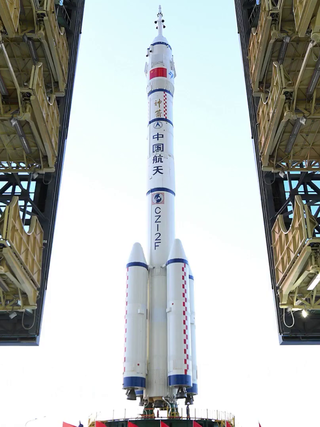
The Long March 2F, also known as the CZ-2F, LM-2F and Shenjian, is a Chinese orbital carrier rocket, part of the Long March 2 rocket family. Designed to launch crewed Shenzhou spacecraft, the Long March 2F is a human-rated two-stage version of the Long March 2E rocket, which in turn was based on the Long March 2C launch vehicle. It is launched from complex SLS at the Jiuquan Satellite Launch Center. The Long March 2F made its maiden flight on 19 November 1999, with the Shenzhou 1 spacecraft. After the flight of Shenzhou 3, CPC General Secretary and President Jiang Zemin named the rocket "Shenjian" meaning "Divine Arrow".

Titan IIIB was the collective name for a number of derivatives of the Titan II ICBM and Titan III launch vehicle, modified by the addition of an Agena upper stage. It consisted of four separate rockets. The Titan 23B was a basic Titan II with an Agena upper stage, and the Titan 24B was the same concept, but using the slightly enlarged Titan IIIM rocket as the base. The Titan 33B was a Titan 23B with the Agena enclosed in an enlarged fairing, in order to allow larger payloads to be launched. The final member of the Titan IIIB family was the Titan 34B which was a Titan 24B with the larger fairing used on the Titan 33B.
Apstar 6 is a communications satellite built by Alcatel Space, a subsidiary of Alcatel, and was boosted into orbit on April 12, 2005, by Long March 3B launcher from Xichang Satellite Launch Center in China. It provides APT Satellite, a satellite operator in the Asia Pacific region, with broadband media and television services. It is fitted with 38 C-band transponders and 12 Ku band transponders. China is covered with a dedicated high power Ku band beam for broadband multimedia transmission. It is the second model of the Spacebus 4000. The transponders have a reduced C-band receiving dish over a wide footprint, which extends across India, China and Australia.
This is a list of the satellites operated by Optus, an Australian telecommunications company. The satellite communications facility is located at Belrose on Sydney's Northern Beaches. Optus' satellites are divided into 4 classes A, B, C and D. As of April 2014 it owns and operates Optus B3, Optus C1, Optus D1, Optus D2 and Optus D3. Optus A1, Optus A2, Optus A3 and Optus B1 satellites have been retired. Optus has the largest network of satellites in Australia and New Zealand.
Long March 2 rocket family or Chang Zheng 2 rocket family as in Chinese pinyin is an expendable launch system operated by the People's Republic of China. The rockets use the abbreviations LM-2 family for export, and CZ-2 family within China, as "Chang Zheng" means "Long March" in Chinese pinyin. They are part of the larger Long March rocket family. Development and design falls mostly under the auspices of the China Academy of Launch Vehicle Technology (CALT).
Intelsat 708 was a telecommunications satellite built by the American company Space Systems/Loral for Intelsat. It was destroyed on February 15, 1996 when the Long March 3B launch vehicle failed while being launched from the Xichang Satellite Launch Center in China. The launch vehicle veered off course immediately after liftoff and struck a nearby village, officially killing at least six people.
The Zenit-3SL is an expendable carrier rocket operated by Sea Launch. First flown in 1999, it has been launched 36 times, with three failures and one partial failure. It is a member of the Zenit family of rockets, and is built by the Yuzhnoye Design Bureau. RKK Energia produces the Block DM-SL upper stage, whilst the payload fairing is produced by Boeing. Launches are conducted from the Ocean Odyssey platform anchored on the equator in the Pacific Ocean, at a point with 154°W longitude, about 370 kilometres east of Kiritimati.

A payload fairing is a nose cone used to protect a spacecraft payload against the impact of dynamic pressure and aerodynamic heating during launch through an atmosphere. An additional function on some flights is to maintain the cleanroom environment for precision instruments. Once outside the atmosphere the fairing is jettisoned, exposing the payload to outer space.
AsiaSat 2 was a Hong Kong communications satellite, which was owned, and was initially operated, by the Hong Kong based Asia Satellite Telecommunications Company. It was positioned in geostationary orbit at a longitude of 17° East of the Greenwich Meridian, on lease to Spacecom. It spent most of its operational life at 100.5° East, from where it was used to provide fixed satellite services, including broadcasting, audio and data transmission, to Asia and the Pacific Ocean.
NigComSat-1 was a Nigerian communication satellite. The initial contract to build the satellite was signed in 2004. It was launched in China by Nasrda and became the third African geosynchronous communication satellite, when it was launched at 16:01 UTC on 13 May 2007, aboard a Chinese Long March 3B carrier rocket, from the Xichang Satellite Launch Centre in China. The spacecraft was operated by Nigerian Communications Satellite Ltd (NIGCOMSAT). On November 11, 2008, NigComSat-1 failed in orbit after running out of power due to an anomaly in its solar array.
ChinaSat is the brand name of communications satellites operated by China Satellite Communications.
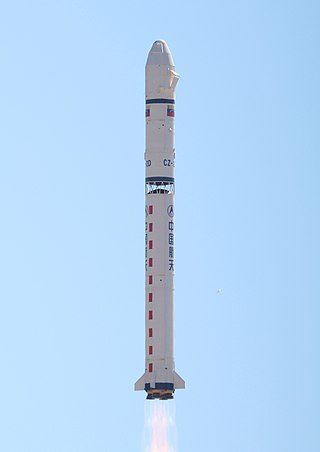
The Long March 2D, also known as the Chang Zheng 2D, CZ-2D and LM-2D, is a Chinese two-stage orbital carrier rocket mainly used for launching LEO and SSO satellites. It is manufactured by the Shanghai Academy of Spaceflight Technology (SAST).
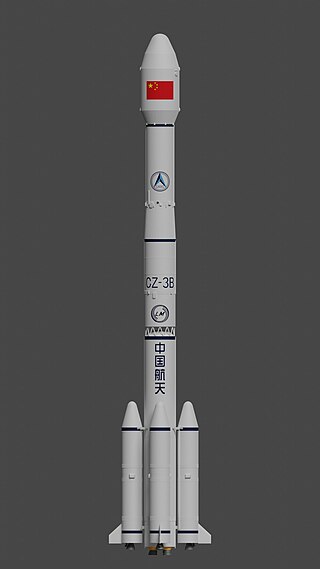
The Long March 3B, also known as the CZ-3B and LM-3B, is a Chinese orbital launch vehicle. Introduced in 1996, it is launched from Launch Area 2 and 3 at the Xichang Satellite Launch Center in Sichuan. A three-stage rocket with four strap-on liquid rocket boosters, it is the heaviest variant of the Long March 3 rocket family, and is mainly used to place communications satellites into geosynchronous orbits.
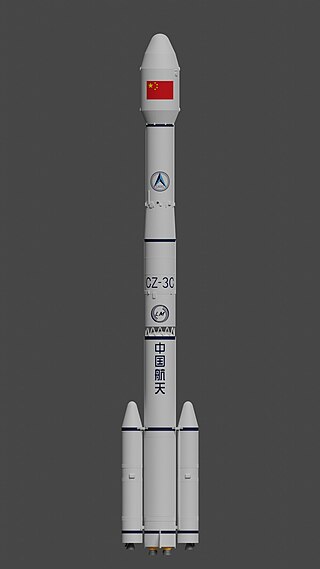
The Long March 3C, also known as the Changzheng 3C, CZ-3C and LM-3C, is a Chinese orbital launch vehicle. It is launched from Launch Complex 2 and 3 at the Xichang Satellite Launch Center (XSLC). A three-stage rocket with two strapon liquid rocket boosters, it is a member of the Long March 3 rocket family, and was derived from the Long March 3B. It was designed to fill a gap in payload capacities between the Long March 3A and 3B.

The Long March 4A, also known as the Changzheng 4A, CZ-4A and LM-4A, sometimes misidentified as the Long March 4 due to the lack of any such designated rocket, was a Chinese orbital carrier rocket. It was launched from Launch Area 7 at the Taiyuan Satellite Launch Center. It was a three-stage rocket, used for two launches in 1988 and 1990. On its maiden flight, on 6 September 1988, it placed the FY-1A weather satellite into orbit. On its second, and final, flight it launched another weather satellite, FY-1B.
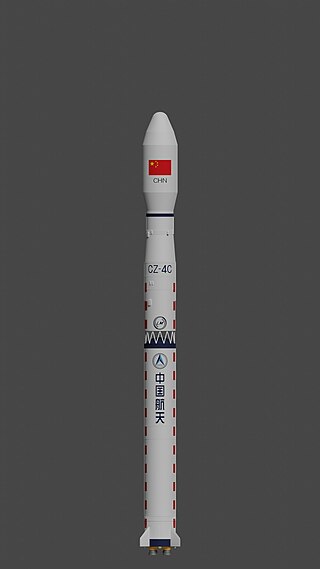
The Long March 4C, also known as the Chang Zheng 4C, CZ-4C and LM-4C, previously designated Long March 4B-II, is a Chinese orbital launch vehicle. It is launched from the Jiuquan, Taiyuan, and Xichang Satellite Launch Centers, and consists of 3 stages. Long March 4C vehicles have been used to launch the Yaogan-1, Yaogan-3 synthetic-aperture radar (SAR) satellites and the Fengyun-3A polar orbiting meteorological satellite. On 15 December 2009, a Long March 4C was used to launch Yaogan-8.
Apstar 2 was a communications satellite based on the Hughes HS-601 spacecraft design, built by Hughes Space and Communications Company for APT Satellite Holdings, a Hong-Kong based company. The satellite was intended to provide video, radio, data, and telephone services to about 2/3 of the world's population. It was launched on Jan. 26, 1995 by a Long March 2E launcher from Xichang Satellite Launch Center in China, but was destroyed 50 seconds after liftoff when the rocket exploded. The failed rocket also veered off course after launch and killed at least six people on the ground.
Apstar-7 is a Chinese communications satellite which is operated by APT Satellite as part of the Apstar system. It was launched in 2012 as a replacement for the Apstar 2R satellite launched in 1997.








